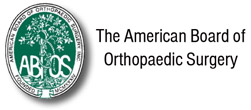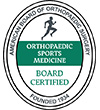What will my shoulder look and feel like after surgery? What is normal?
Your shoulder will be wrapped in a dressing, you may see some dried blood or clear fluid in the gauze. Once you remove your dressing, you may see mild black-and-blue markings around the incisions. These sometimes develop a few days after surgery. You may experience swelling and discomfort in the shoulder for several days to a week after surgery.
What medications have I been prescribed?
You will be instructed to use Ibuprofen (Motrin, Advil) and Acetaminophen (Tylenol) regularly for post-operative pain management. You can take up to 800mg of Ibuprofen three times a day. We recommend you take it with breakfast, lunch and dinner and do not take it on an empty stomach. You can alternate 650mg Acetaminophen (Tylenol extra strength) with the ibuprofen as needed.
You have also been provided a narcotic medication for pain, please take as prescribed. This is to be taken only as needed for pain. We recommend taking it at night/before bedtime and you should decrease the amount you take as the pain improves. Drink plenty of water and use the prescribed stool softener if you are using regularly, as the narcotic can cause constipation. Do not drive, drink alcohol, or operate machinery/ appliances while taking this medication. Narcotic medication can be highly addictive, please only take as needed and contact the office with any concerns.
Should I be icing my shoulder?
You may use ice bags or cryotherapy device to help control pain and swelling in your shoulder. We recommend you ice for 30 minutes every hour or two. This is most important the first few days following surgery. Do not apply ice, directly to skin. Make sure you use a towel or t-shirt between ice and your skin for protection.
When can I remove my dressing? When can I shower?
We ask that you keep the dressing clean, dry, and intact for 3 days after surgery. After this time, you may remove the dressing and shower. You will notice thin white strips covering each of your incisions, these are steri-strips. Please, leave these on until your first post-operative appointment. They may fall off on their own, this is okay. You may come out of your brace to shower, being careful to keep your arm by your side - do not lift with or raise your affected arm. You may allow water to run over your incisions. After, pat dry and cover each incision with band-aids. Do not soak your incisions (hot tub, bath, etc.). Do not put any ointments on your incisions.
When can I start moving my arm?
You can begin moving your elbow, hand, and wrist on the day of your surgery. Do not move the shoulder that was operated on. You may use the foam ball attached to your brace when you experience swelling in your hand. Grip the ball several times a day as needed. If swelling does not subside, please call the office. You can come out of the brace to do pendulum exercises with your arm at your side. You will begin physical therapy 2 weeks after surgery.
When can I drive?
You will be able to drive at 6 weeks post-operatively when your sling/brace is discontinued.
If you are comfortable driving prior to 6 weeks, then your sling must be removed in to order to operate a motor vehicle. Once you get where you are going, then the sling/brace should be put back on.
There is absolutely no driving while under the influence of narcotics, this is against the law. Narcotics impair your judgement and physical ability to respond while driving.
When are my follow-up appointments? What’s the rehab timeline?
After your surgery you will have follow-up appointments around 2 weeks, 6 weeks, and 3 months post-op. You will begin physical therapy after two weeks. You will remain in your brace for the first 6 weeks. It takes 3 months for the rotator cuff to heal and 6 months to completely rehab from shoulder surgery.





